On The Yucatán Peninsula, Campache, México.
Travel & Tour
Pictures, Photos, Images, & Reviews.
George & Eve DeLange
Google Map To The Chicanna Archaeological Ruins.
On The Yucatán Peninsula, Campache, Rio Bec Region, Mexico.
View Larger Map
Click On Any Of The Following Links By Amazon.Com
For Books Or Videos About Touring The Yucatán Peninsula In Mexico. No Obligation!
We Are Proud Of Our SafeSurf Rating!
Click On Any Of The Following Links By Amazon.Com
For Books Or Videos About Touring The Yucatán Peninsula In Mexico. No Obligation!
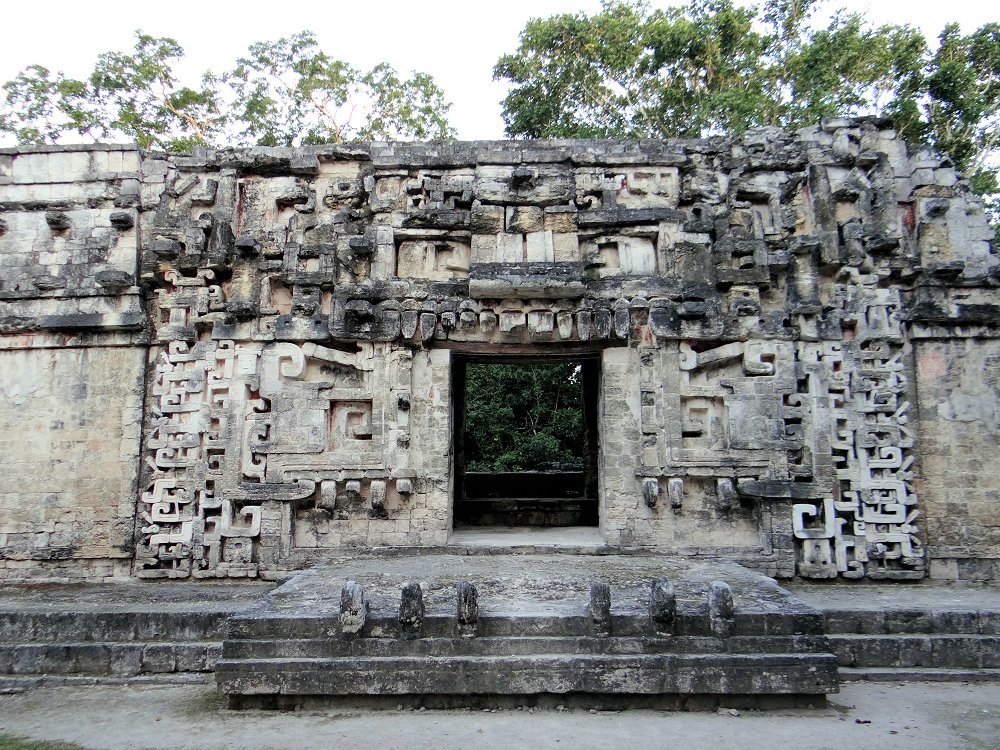
The Main Attraction At Chicanná Archaeological Ruins Is Group A, Structure II.
The Mask Probably Represents Itzamna, The Creator-God.
Photo Taken November 14, 2012.
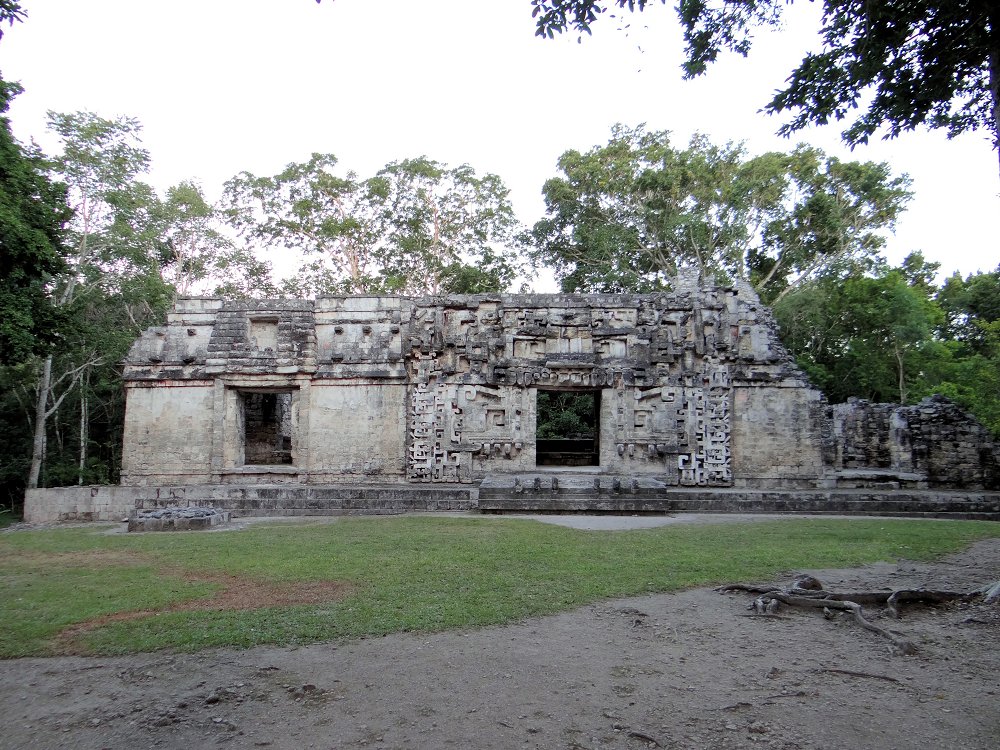
The Main Attraction At Chicanná Archaeological Ruins Is Group A, Structure II.
The Mask Probably Represents Itzamna, The Creator-God.
Photo Taken November 14, 2012.

The Main Attraction At Chicanná Archaeological Ruins Is Group A, Structure II.
The Mask Probably Represents Itzamna, The Creator-God.
Photo Taken February 2004.

Eve DeLange With Itzamna At Group A, Structure II.
The Mask Probably Represents Itzamna, The Creator-God.
Photo Taken November 14, 2012.
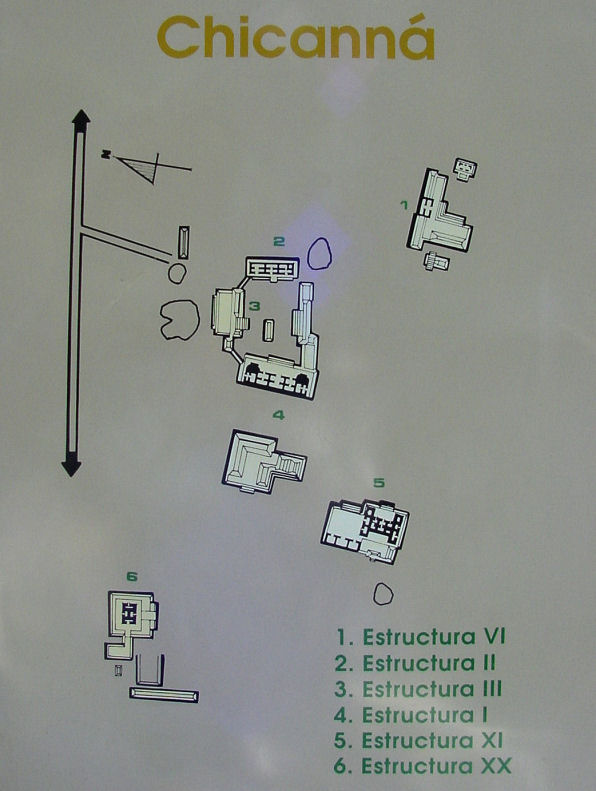
Chicanná Archaeological Ruins Site Map.
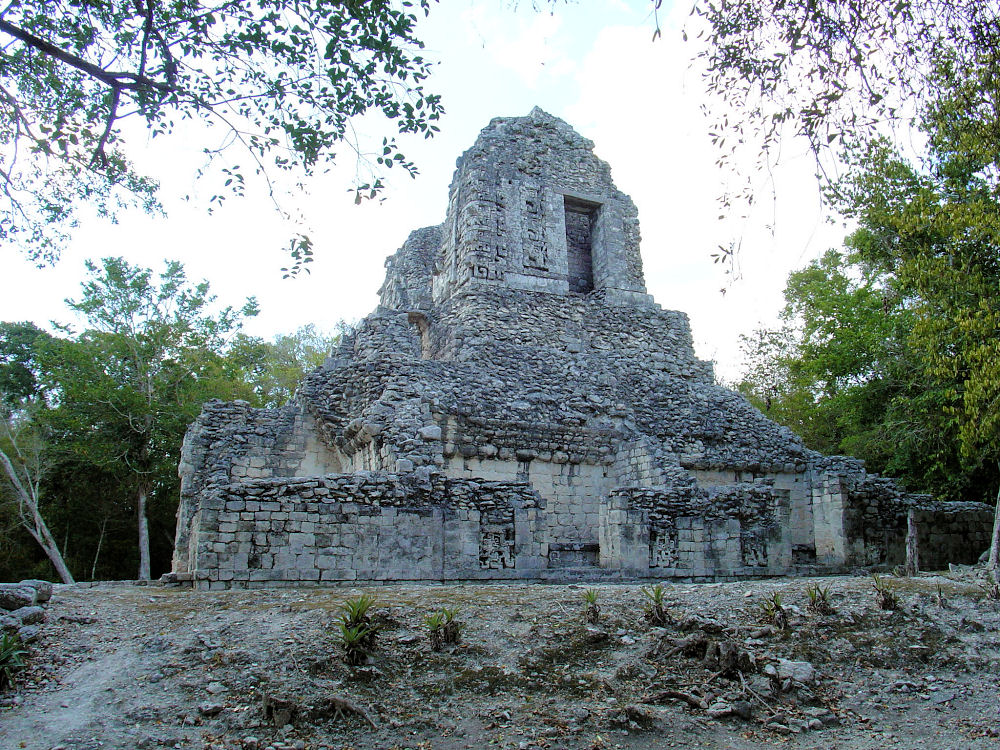
Chicanná Archaeological Ruins. Group D, Structure XX.
The Tallest Structure At Chicanná.
Shows The Prominently - Nosed Rain God Chac On The Corners Of The Temple.
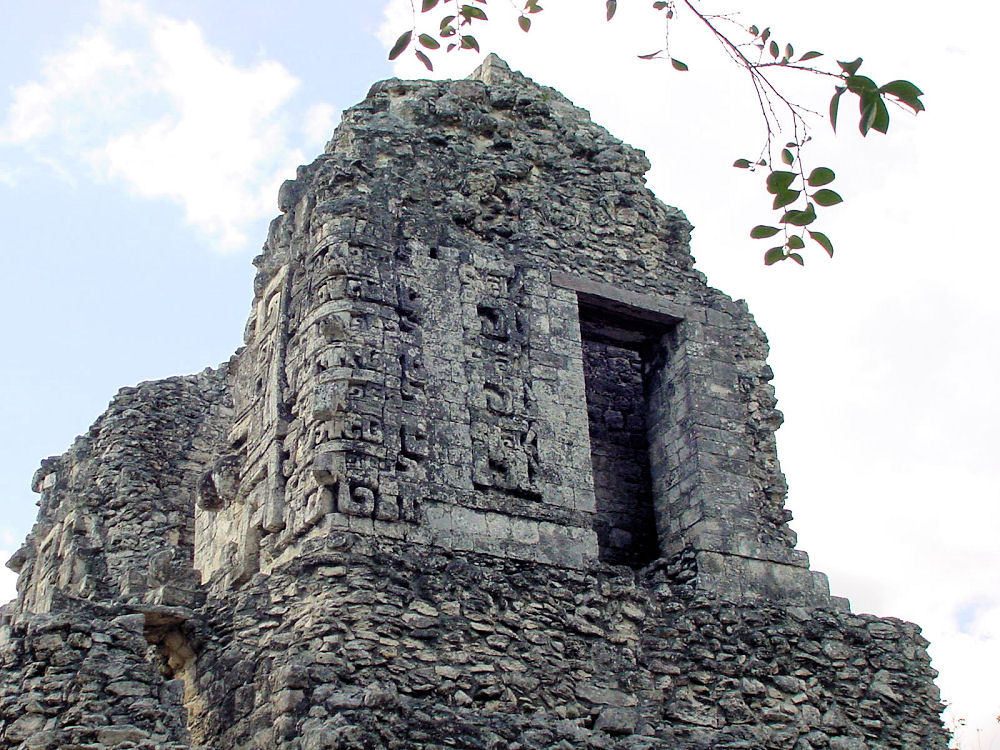
Chicanná Archaeological Ruins. Group D, Structure XX.
Shows The Prominently - Nosed Rain God Chac On The Corners Of The Temple.
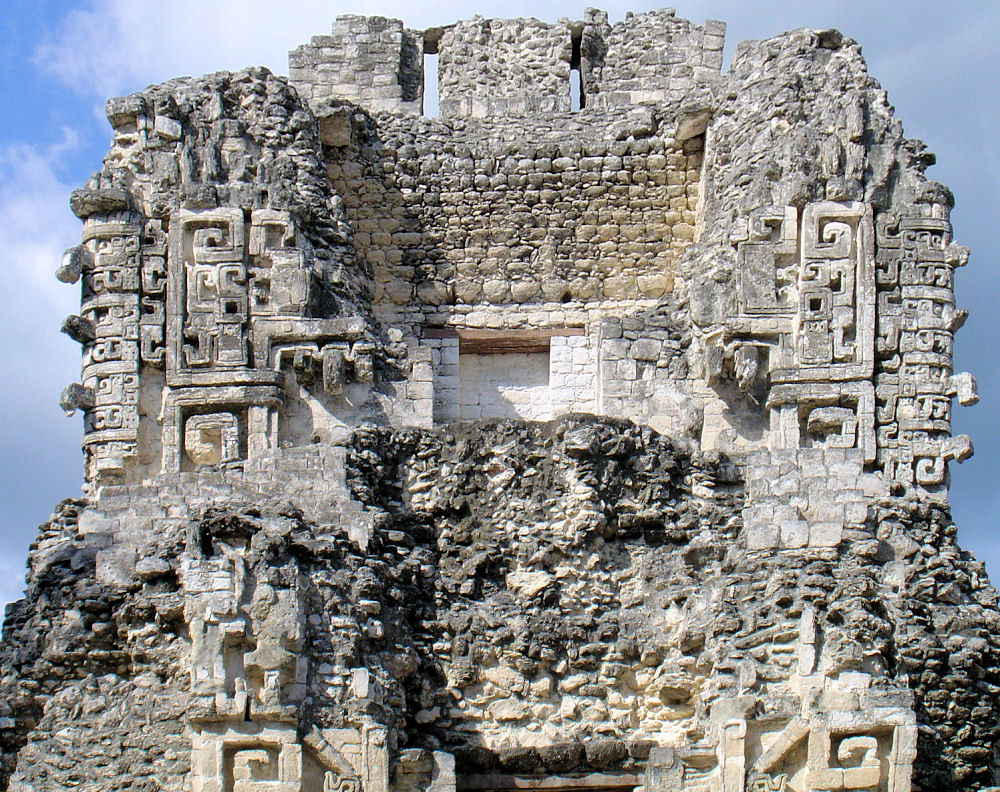
Chicanná Archaeological Ruins. Group D, Structure XX.
Shows The Prominently - Nosed Rain God Chac On The Corners Of The Temple.
Chicanná means "Serpent-Mouth House" or "House Of The Snake's Jaws" in Mayan. Chicanná is located near the site of Becán and is reachable by car. While it is a close neighbor to Becán the architecture at the two sites is quite the same.
The three sites; Chicanná, Becán, & Xpujil are easy sites to visit of the Rio Bec Region located in the Mexican State of Campache on the Yucatán Peninsula. There are many others but they are not easily seen by tourists.
A word about the Río Bec Region. The words Río Bec refer to a style of the temple pyramids which are located in the central Maya lowlands. The temple-pyramids are characterized by a unique architectural style that began to appear during the seventh century A.D. and continued into the early twelfth century A.D. The temple - pyramids usually have what is called a range-type of building with a similar looking, nonfunctional tower; on each of the opposit ends of the range-type building.
As the height of the twin towers increases, the twin towers narrow; giving the illusion of being greater in height than they actually are. In addition, the twin-towers appear to have stairs along their faces leading to the temple that rests atop them. However, the steps are only a design motif that creates the illusion of functional stairs.
The temples, which appear to be located on the singular platform at the top each of the Río Bec towers are solid masses of design stone, with no interior rooms, so they are inoperative as well. Also, there are
Pseudo-doorways, built into niches, located at the fronts of the temples, giving the temple the appearance of having a functional door. The purpose of the Río Bec temple-pyramids is unknown at this time. But, they are pretty!
Chicanná was discovered and named by Jack D. Eaton in 1966 during a reconnaissance of the area prior to the formal start of the National Geographic/Tulane University archaeological study centered at Becán.
The ancient name of Chicanná is not known. Chicanná and its close neighbor, Becán, were built during the same time period (about A.D. 600 to 830).
However, there is evidence that its earliest occupation begins during the Late Pre-Classic Era (300 B.C. to 250 A.D.). The cultural peak of Chicanná is during the Late Classic period (550 to 700 A.D.).
Chicanná appears to have been inhabited up to about 1,100 A.D. and it appears to have been dependent upon the much larger city of Becán.
Chicanná is a good example of a blending of the Chenes and the Bec River styles and it is known for its elaborate stone architecture. Chicanná features facades that portray the gaping jaws of Itzamná, the chief deity of the Maya gods in the form of the "Earth Monster".
At Group A, Structure II; the priests would have entered the doorway is his great mouth, through which they would have entered the Maya underworld. When they emerged they would have been transfigured by the encounter.
On each side of the door itself are the gaping fangs of the serpent. The facade of Group D, Structure XX; also portrays large fangs, while on the shrine atop it, there are jutting stone masks with huge twisted snouts, of the Rain God Chac.
Chicanná appears to have been inhabited up to about 1100 A.D. and appears to have been dependent on the much larger city of Becán for much of its existence.
The Ing. Alberto Acuña Ongay International Airport (IATA: CPE, ICAO: MMCP), also known as Campeche International Airport, is the international airport located in Campeche, Campeche, Mexico. It handles the national and international air traffic of the city of Campeche. It's operated by Aeropuertos y Servicios Auxiliares, a federal government-owned corporation.
There are several good hotels or motels in the Campeche area, and if you need a place to stay; Priceline.com can arrange that for you. In fact, we think they are the best way to do it!
We also have links on this page, that will connect you directly with several of the best hotels in in the Campeche area. Hotels that we have personally used!
We suggest getting a hotel, and then letting them arrange for either a car, or a tour of the Campeche area and/or the Río Bec Region. If you call their Concierge Services, ahead of your arrival, all of this can be pre-arranged for you.
We have used this method, many times, when traveling in Mexico. We have found it to be safe and it works!!! We have never experienced a problem, doing it this way!
Our first choice for exploring this region (only due to their location) is the Chicanna Ecovillage Resort at Xpujil. It is an OK place to stay but, don't expect a 5 star rating hotel. Their staff is not known to be helpful. There are no other nice places to stay in this central location. Hotels that are higher rated are only found in Campeche.
We have personally, booked flights, hotels, and vacations, through Priceline.com and we can highly recommend them. Their website is very easy to use!
We have some links to Priceline.com on this page, since they can arrange all of your air flights, hotels and car.
We of course, appreciate your use of the advertising on our pages, since it helps us to keep our pages active.
Click On Any Of The Following Links By Amazon.Com
For Books Or Videos About Touring The Yucatán Peninsula In Mexico. No Obligation!
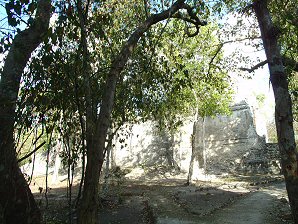
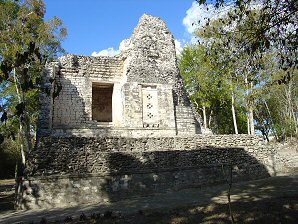
Chicanná: Group A, Structure One
West Side Chicanná: Group A, Structure One
South Side 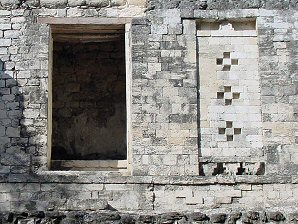

Cross Structures
Chicanná: Group A, Structure One Structure One Aligns 10 Degrees
From True NS, Faces East
A Two Tower Structure 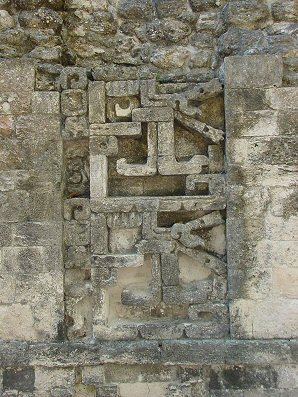

Stylized Profile Serpent Heads Stylized Profile Serpent Heads 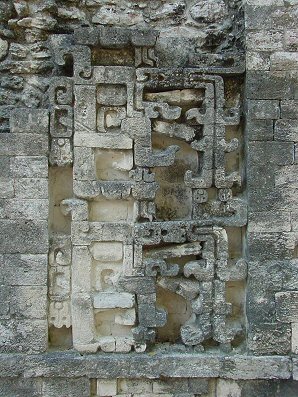
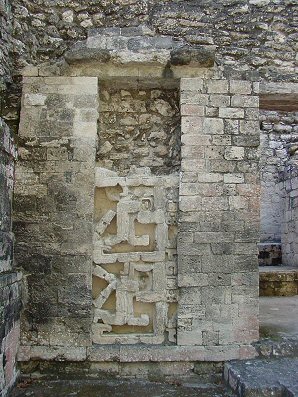
Stylized Profile Serpent Heads Stylized Profile Serpent Heads 
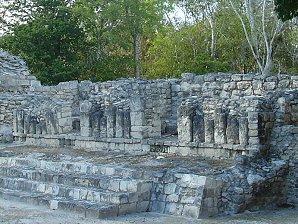
Chicanná: Group A,
Structure III Chicanná: Group A,
Structure III
Column Detail 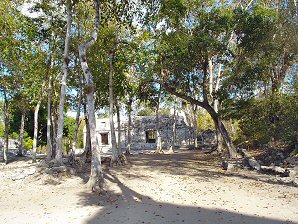
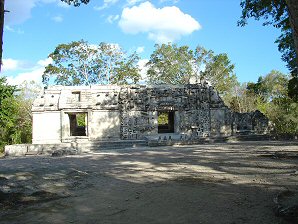
Chicanná: Structure II, Group A
Appears To Be In Three Sections
The Left And Right Are Plain Chicanná: Structure II, Group A
The Center Section Is an Ornate
Monster Mouth With Upper Fangs 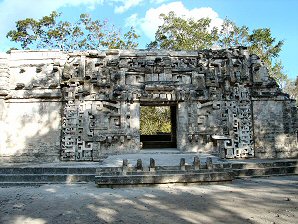
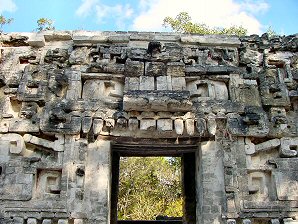
Chicanná: Structure II,
Mask Represents
Itzamna, The Creator-God Chicanná: Structure II,
Mask Detail
Itzamna. Chicanná: Structure II
Left Mask Detail Chicanná: Structure II
Right Mask Detail 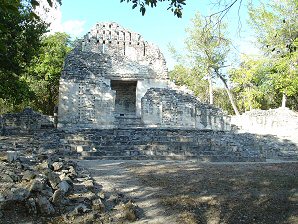
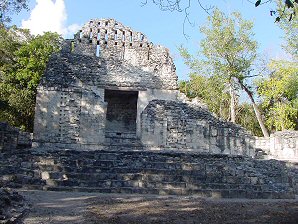
Structure Six Structure Six 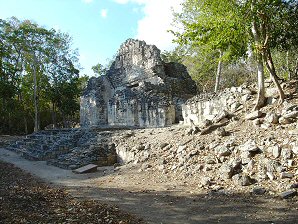
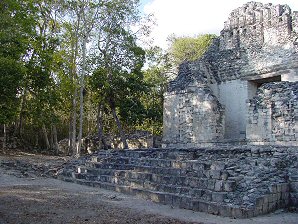
Structure Six Structure Six
We Are Proud Of Our SafeSurf Rating!
Click On Any Of The Following Links By Amazon.Com
For Books Or Videos About Touring In Mexico. No Obligation!
Here Are Some Links To The Very Best & Most Popular Items Sold On Amazon.Com
To Learn More! Click The Links Below. No Obligation, Of Course!


Other Rio Bec Region Ruins!
For Books Or Videos About Touring The Yucatán Peninsula In Mexico. No Obligation!
 |
| The Main Attraction At Chicanná Archaeological Ruins Is Group A, Structure II. The Mask Probably Represents Itzamna, The Creator-God. Photo Taken November 14, 2012. |
|---|
 |
| The Main Attraction At Chicanná Archaeological Ruins Is Group A, Structure II. The Mask Probably Represents Itzamna, The Creator-God. Photo Taken November 14, 2012. |
|---|
 |
| The Main Attraction At Chicanná Archaeological Ruins Is Group A, Structure II. The Mask Probably Represents Itzamna, The Creator-God. Photo Taken February 2004. |
|---|
 |
| Eve DeLange With Itzamna At Group A, Structure II. The Mask Probably Represents Itzamna, The Creator-God. Photo Taken November 14, 2012. |
|---|
 |
| Chicanná Archaeological Ruins Site Map. |
|---|
 |
| Chicanná Archaeological Ruins. Group D, Structure XX. The Tallest Structure At Chicanná. Shows The Prominently - Nosed Rain God Chac On The Corners Of The Temple. |
|---|
 |
| Chicanná Archaeological Ruins. Group D, Structure XX. Shows The Prominently - Nosed Rain God Chac On The Corners Of The Temple. |
|---|
 |
| Chicanná Archaeological Ruins. Group D, Structure XX. Shows The Prominently - Nosed Rain God Chac On The Corners Of The Temple. |
|---|
Chicanná means "Serpent-Mouth House" or "House Of The Snake's Jaws" in Mayan. Chicanná is located near the site of Becán and is reachable by car. While it is a close neighbor to Becán the architecture at the two sites is quite the same. The three sites; Chicanná, Becán, & Xpujil are easy sites to visit of the Rio Bec Region located in the Mexican State of Campache on the Yucatán Peninsula. There are many others but they are not easily seen by tourists. A word about the Río Bec Region. The words Río Bec refer to a style of the temple pyramids which are located in the central Maya lowlands. The temple-pyramids are characterized by a unique architectural style that began to appear during the seventh century A.D. and continued into the early twelfth century A.D. The temple - pyramids usually have what is called a range-type of building with a similar looking, nonfunctional tower; on each of the opposit ends of the range-type building. As the height of the twin towers increases, the twin towers narrow; giving the illusion of being greater in height than they actually are. In addition, the twin-towers appear to have stairs along their faces leading to the temple that rests atop them. However, the steps are only a design motif that creates the illusion of functional stairs. The temples, which appear to be located on the singular platform at the top each of the Río Bec towers are solid masses of design stone, with no interior rooms, so they are inoperative as well. Also, there are Pseudo-doorways, built into niches, located at the fronts of the temples, giving the temple the appearance of having a functional door. The purpose of the Río Bec temple-pyramids is unknown at this time. But, they are pretty! Chicanná was discovered and named by Jack D. Eaton in 1966 during a reconnaissance of the area prior to the formal start of the National Geographic/Tulane University archaeological study centered at Becán. The ancient name of Chicanná is not known. Chicanná and its close neighbor, Becán, were built during the same time period (about A.D. 600 to 830). However, there is evidence that its earliest occupation begins during the Late Pre-Classic Era (300 B.C. to 250 A.D.). The cultural peak of Chicanná is during the Late Classic period (550 to 700 A.D.). Chicanná appears to have been inhabited up to about 1,100 A.D. and it appears to have been dependent upon the much larger city of Becán.
Chicanná is a good example of a blending of the Chenes and the Bec River styles and it is known for its elaborate stone architecture. Chicanná features facades that portray the gaping jaws of Itzamná, the chief deity of the Maya gods in the form of the "Earth Monster". At Group A, Structure II; the priests would have entered the doorway is his great mouth, through which they would have entered the Maya underworld. When they emerged they would have been transfigured by the encounter. On each side of the door itself are the gaping fangs of the serpent. The facade of Group D, Structure XX; also portrays large fangs, while on the shrine atop it, there are jutting stone masks with huge twisted snouts, of the Rain God Chac. Chicanná appears to have been inhabited up to about 1100 A.D. and appears to have been dependent on the much larger city of Becán for much of its existence.
|
The Ing. Alberto Acuña Ongay International Airport (IATA: CPE, ICAO: MMCP), also known as Campeche International Airport, is the international airport located in Campeche, Campeche, Mexico. It handles the national and international air traffic of the city of Campeche. It's operated by Aeropuertos y Servicios Auxiliares, a federal government-owned corporation. There are several good hotels or motels in the Campeche area, and if you need a place to stay; Priceline.com can arrange that for you. In fact, we think they are the best way to do it! We also have links on this page, that will connect you directly with several of the best hotels in in the Campeche area. Hotels that we have personally used! We suggest getting a hotel, and then letting them arrange for either a car, or a tour of the Campeche area and/or the Río Bec Region. If you call their Concierge Services, ahead of your arrival, all of this can be pre-arranged for you. We have used this method, many times, when traveling in Mexico. We have found it to be safe and it works!!! We have never experienced a problem, doing it this way! Our first choice for exploring this region (only due to their location) is the Chicanna Ecovillage Resort at Xpujil. It is an OK place to stay but, don't expect a 5 star rating hotel. Their staff is not known to be helpful. There are no other nice places to stay in this central location. Hotels that are higher rated are only found in Campeche. We have personally, booked flights, hotels, and vacations, through Priceline.com and we can highly recommend them. Their website is very easy to use! We have some links to Priceline.com on this page, since they can arrange all of your air flights, hotels and car. We of course, appreciate your use of the advertising on our pages, since it helps us to keep our pages active.
|
Click On Any Of The Following Links By Amazon.Com
For Books Or Videos About Touring The Yucatán Peninsula In Mexico. No Obligation!


Chicanná: Group A, Structure One
West Side Chicanná: Group A, Structure One
South Side 

Cross Structures
Chicanná: Group A, Structure One Structure One Aligns 10 Degrees
From True NS, Faces East
A Two Tower Structure 

Stylized Profile Serpent Heads Stylized Profile Serpent Heads 

Stylized Profile Serpent Heads Stylized Profile Serpent Heads 

Chicanná: Group A,
Structure III Chicanná: Group A,
Structure III
Column Detail 

Chicanná: Structure II, Group A
Appears To Be In Three Sections
The Left And Right Are Plain Chicanná: Structure II, Group A
The Center Section Is an Ornate
Monster Mouth With Upper Fangs 

Chicanná: Structure II,
Mask Represents
Itzamna, The Creator-God Chicanná: Structure II,
Mask Detail
Itzamna. Chicanná: Structure II
Left Mask Detail Chicanná: Structure II
Right Mask Detail 

Structure Six Structure Six 

Structure Six Structure Six
 |  |
| Chicanná: Group A, Structure One West Side | Chicanná: Group A, Structure One South Side |
|---|---|
 |  |
| Cross Structures Chicanná: Group A, Structure One | Structure One Aligns 10 Degrees From True NS, Faces East A Two Tower Structure |
 |  |
| Stylized Profile Serpent Heads | Stylized Profile Serpent Heads |
 |  |
| Stylized Profile Serpent Heads | Stylized Profile Serpent Heads |
 |  |
| Chicanná: Group A, Structure III | Chicanná: Group A, Structure III Column Detail |
 |  |
| Chicanná: Structure II, Group A Appears To Be In Three Sections The Left And Right Are Plain | Chicanná: Structure II, Group A The Center Section Is an Ornate Monster Mouth With Upper Fangs |
 |  |
| Chicanná: Structure II, Mask Represents Itzamna, The Creator-God | Chicanná: Structure II, Mask Detail Itzamna. |
| Chicanná: Structure II Left Mask Detail | Chicanná: Structure II Right Mask Detail |
 |  |
| Structure Six | Structure Six |
 |  |
| Structure Six | Structure Six |
We Are Proud Of Our SafeSurf Rating!
Click On Any Of The Following Links By Amazon.Com
For Books Or Videos About Touring In Mexico. No Obligation!
Here Are Some Links To The Very Best & Most Popular Items Sold On Amazon.Com
To Learn More! Click The Links Below. No Obligation, Of Course!


Other Rio Bec Region Ruins!
Here Are Some Links To The Very Best & Most Popular Items Sold On Amazon.Com
To Learn More! Click The Links Below. No Obligation, Of Course!


Other Rio Bec Region Ruins!
